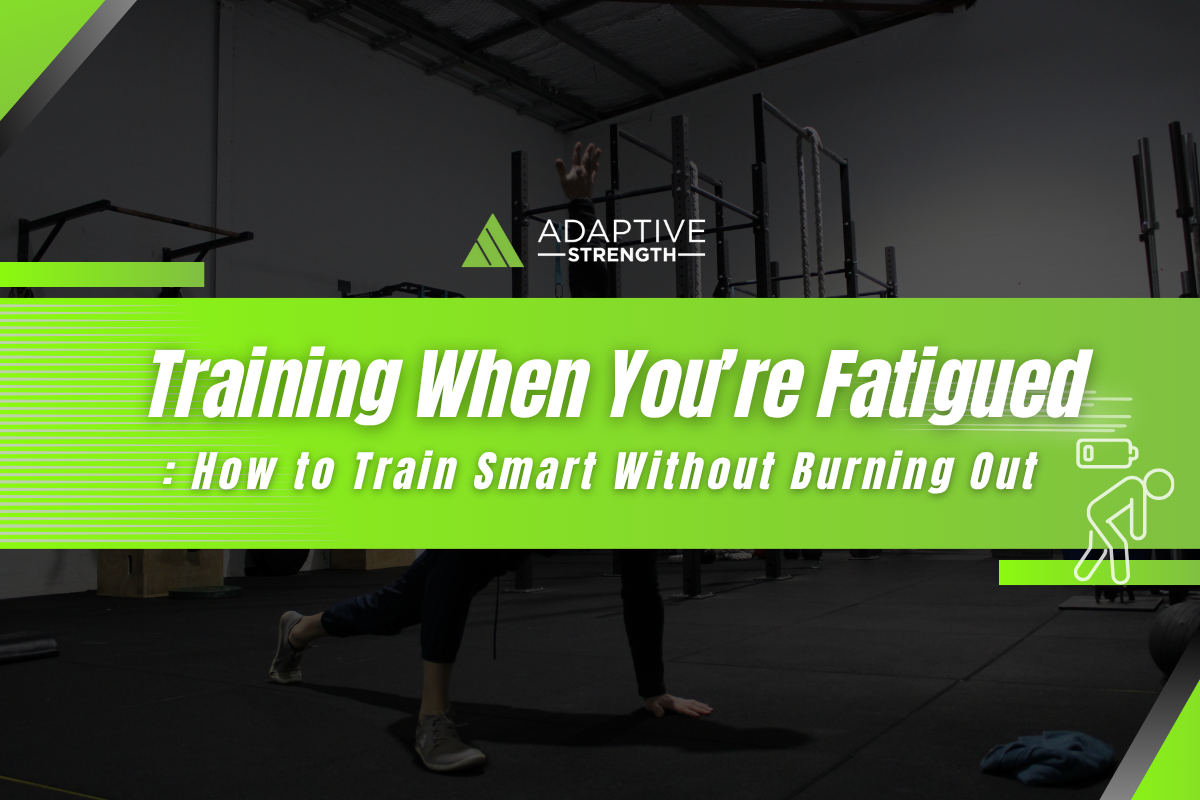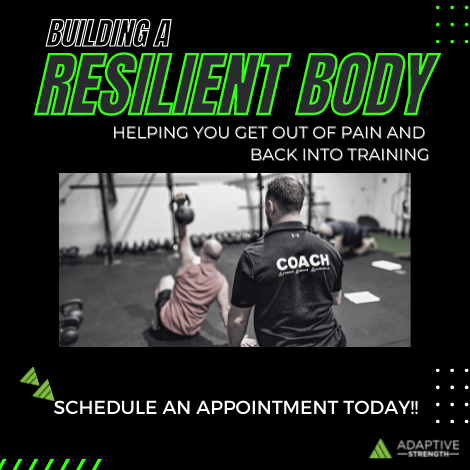At some point, we all feel it — fatigue that makes getting through the day hard enough, let alone getting through a workout. Whether it’s from work stress, poor sleep, parenting duties, or health challenges, the result is the same: low energy, low motivation.
But here’s the good news — you don’t have to stop training altogether.
At Adaptive Strength, we work with people in all kinds of situations — athletes recovering from injury, shift workers juggling energy, and everyday people just trying to stay consistent. When fatigue sets in, we don’t stop training — we adapt. This article shows you how to train smart when you’re feeling tired or rundown, so you can maintain progress without running yourself into the ground.
Strength Training Is the Best Option When You’re Tired
If you’re experiencing fatigue, strength training is often the best option.
Why? Because it offers a high return with relatively low fatigue cost — especially when compared to high-intensity cardio or long endurance sessions. You can build and maintain muscle, support your metabolism, improve joint health, and enhance recovery without pushing your heart rate through the roof.
The key is to keep the session simple, focused, and efficient.
Avoid HIIT and High-Intensity Cardio
This is where most people go wrong. When energy is low, they try to push through with a “sweat-it-out” mindset — doing intense circuits, long cardio sessions, or HIIT workouts.
But the problem is, these sessions spike stress hormones, increase inflammation, and often leave you feeling worse. When your body’s already under stress, more stress isn’t the solution.
Instead, drop the intensity. You’ll recover faster, sleep better, and come back stronger.
Keep the Rep Range Low
When you’re fatigued, it’s not the time to chase volume or burn yourself out with 15-20 rep sets.
Aim for 3–5 reps per set with submaximal weight. This lets you maintain good form, reduce the chance of overreaching, and keep your nervous system calm. Fewer reps done well are far more valuable than more reps done poorly — especially when you’re running on limited reserves.
Focus on quality over quantity.
Rest as Needed Between Sets
Forget the stopwatch. When you’re tired, there’s no shame in taking more rest between sets.
Let your breathing return to normal. Give your body a moment to recover. A well-rested set of 3 reps will do more for you than rushing through 5 fatigued sets just to “get it done.”
It’s not lazy — it’s strategic.
Use Active Recovery Between Strength Exercises
If you don’t want to stand around between sets, you can still keep moving — just gently.
We often program mobility drills, breathing exercises, or light carries between strength work. These low-intensity movements help keep the body loose, stimulate blood flow, and reduce stiffness — all without draining your tank.
Think 90/90 hip mobility, deep squats, controlled breathing, or band pull-aparts. They help restore balance and reduce the feeling of “heaviness” that often comes with fatigue.
Manage Load — Don’t Chase PBs
Now is not the time to max out or prove a point.
Instead of going for heavy lifts, stick to submaximal loads. Use something like an RPE scale (Rate of Perceived Exertion) and aim for 6–7/10 effort. That means you could do 2–4 more reps if you had to — but you stop short on purpose.
This keeps your joints safe, your technique sharp, and your body responsive rather than reactive.
You Should Leave the Session Feeling Better Than You Arrived
This is one of our core training principles at Adaptive Strength — and it’s even more important when you’re tired.
If you leave the gym more exhausted, inflamed, or mentally foggy than when you walked in… something’s off. The right session, tailored to your energy level, should leave you feeling better. You might not set records, but you’ll walk out moving smoother, breathing easier, and thinking clearer.
It’s not about smashing yourself — it’s about supporting your body.
Even a Short Session Counts
If you’re tired, 20–30 minutes of quality training is more than enough. It might be 3 exercises, a few warm-up sets, and you’re done. That still counts. That still builds momentum.
Don’t fall into the trap of “all or nothing.” Show up, do what you can, and get out. Some movement is always better than none.
Sometimes the Smartest Move Is a Mobility Day
This article is about training smart through fatigue — and sometimes that means pulling right back and just moving gently.
If you’re sleep-deprived, burned out, or feeling run down, a full training session might not be the best choice. But that doesn’t mean you have to skip movement entirely.
Instead, turn it into a mobility day.
Go for a walk. Spend 20–30 minutes doing gentle stretching, breathing exercises, or light mobility drills. Open up the hips, move the spine, and release tension in areas that usually get tight. You’ll improve circulation, reduce stiffness, and reset your body — all without adding more stress.
At Adaptive Strength, we strategically incorporate mobility days into our clients’ programs for this exact reason. They’re a powerful way to stay consistent, support recovery, and keep progressing — even on days when energy is low.
Not every session needs to push the limits. Some days, the best thing you can do is move slowly, breathe deeply, and give your body what it truly needs.
Final Thoughts: Train to Support, Not Deplete
At Adaptive Strength, our goal is simple: help you train for life. That means adjusting your training to suit your current capacity — not fighting your body every step of the way.
Fatigue doesn’t mean failure. It means your body is sending a signal — and we help you listen. With the right approach, you can maintain your strength, build resilience, and feel better even when energy is low.
If you’re struggling with fatigue and not sure how to keep training, our coaches can guide you through a plan that fits your body and your life.
Book a free strategy session today — and learn how to train smart, even on your toughest days.





